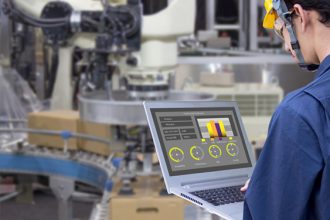Maintenance Check: From Reactive to Predictive

Modern tools are changing the way you maintain your equipment—with big savings to be had.
The normal, long-standing tradition with material handling equipment is to react when something fails. Your conveyor grinds to a halt and you bring in your maintenance team to fix it. Your pick-to-light machine stops lighting up and, again, in comes maintenance. The attitude has long been that maintenance is a costly and necessary evil. While in the past there were few options other than reacting to equipment failures, today there are far more advanced ways to keep your equipment operational and productive. And when your equipment is working, so too are your operations, saving you costly downtime while avoiding reduced capacity issues and lost labor hours.
Beyond reactive maintenance, there’s a spectrum of methods for keeping your material handling equipment up and running. The next level up from reactive maintenance is preventative maintenance. Think about how you usually take care of your car—you operate on a schedule, tending to certain parts or areas on a recommended schedule from the OEM. You might change your oil every 4,000 miles, for instance, hoping to keep issues at bay. This is the same approach to preventative maintenance of material handling equipment.
Next up the ladder is condition-based monitoring, a more sophisticated method to maintenance. To efficiently condition monitor, you capture data from your equipment via sensors that send alerts for changes in the condition of your equipment. A team member or a third-party company analyzes the sensor data to determine the maintenance needs. With these alerts, you can get ahead of a problem hours or days before it impacts operations. This method often requires human intervention and knowledge of the behavior of the equipment being monitored. If a motor is consistently running at a higher-than-normal temperature, for instance, you’ll know it and your team can tend to it before a failure.
Predictive maintenance is the next level of sophistication, providing a better, more targeted analysis of how much longer equipment can go before needing repair, refurbishment, or replacement. Working data captured from current running conditions of your equipment, AI and machine learning can predict anywhere from days, to weeks, to months in advance of an oncoming issue. This provides a host of advantages, including reducing the labor hours needed to keep the equipment running. Additional advantages are being able to schedule your maintenance for convenient hours—when the warehouse or plant isn’t operating, for instance—and making sure you have the right spare parts in inventory. Predictive maintenance is deliberate and specific, providing much better scheduling and freeing up your team to become strategic in the actions they perform.
If you’re interested in moving in this direction, you’ll need to upgrade and add systems to help with the data capture. Many of today’s new models of equipment come with “smart” components in place, but retrofitting may be an option depending on the age of your equipment. You’ll need sensors to track vibration and temperature, flow meters, the ability to capture RPMs and pressure, and the ability to provide context for what you’re measuring. For example, your conveyor belt may operate differently when moving a 250-lb item versus a 50-lb item. You’ll also want to track previous and ongoing maintenance data to feed that into the machine learning system.
By reframing your maintenance program for cost savings versus avoiding the cost of unplanned downtime, the case is there for condition monitoring and predictive maintenance. Now is the time to start preparing for the future of maintenance.
For more information about the Solutions Community: mhi.org/solutions-community
For further articles from the Solutions Community:
Digitization of Intralogistics—Replenishment
Digitization Of Intralogistics: Labor
Digital Twin for Intralogistics
The Digitization of Intralogistics: Returns
Past vs. Future: The Difference Between On-Premise and Cloud-Based WMS



